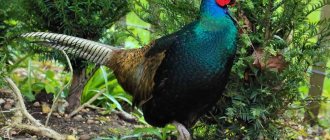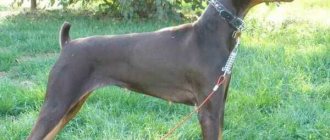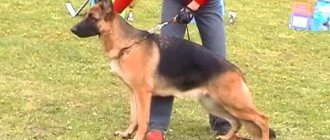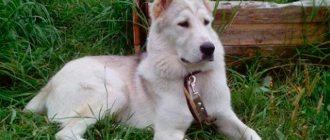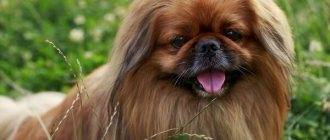Home » Articles about pheasants » Female pheasant
Pheasant is a game object and one of the domesticated bird species. It is possible to distinguish a female pheasant from a male at an early age. As they grow, the differences become more pronounced.
External differences
You can distinguish a female from a male pheasant already at one day of age by examining the chick's cloaca - if there is a tubercle on the inner wall, then the sex is male, if not, then the sex is female. At the age of one month, the eyes of males lighten, while those of females remain dark.
Adult birds are strikingly different. Males have brighter and more beautiful plumage - this applies to almost any species. They have a long wedge-shaped tail. The female pheasant looks more modest; it is easy for her to camouflage herself among the grass and bushes. It is smaller in size (almost 2 times less in weight than the male) - on average its weight is 0.7-1 kg. Body length is about 60 cm.
The color of the feathers is gray-sandy, dull brown, brownish-ochre or other, but in any case, it barely stands out against the background of the natural landscape. The feathers have specks or stripes of dark or light color. They make an additional contribution to camouflage. The color of the tail feathers does not differ from the general background. The beak has a grayish color.
Female pheasants molt later than males - the latter change their feathers while the hens are still sitting on the clutch. Females molt when the chicks gain approximately 2/3 of the adult weight. There are also differences in the voice - females are silent, only in a moment of fright do they emit a thin squeak. Males have a two-syllable, rough cry.
Pheasant feeding
In the wild, under natural conditions, the pheasant's diet mostly consists of plant foods. To satisfy hunger, pheasants eat plant seeds, berries, rhizomes, young green shoots and leaves. Animal food is also important for birds; they eat worms, larvae, insects, and spiders.
A characteristic feature of these birds is that from birth the chicks feed exclusively on animal food, and only after some time they switch to plant food.
Pheasants get their food on the ground, raking fallen leaves, soil and grass with their fairly strong paws, or they peck food from plants at a small height from the ground.
Features of the life of wild individuals
In the wild, representatives of the pheasant family live 5-7 years, in rare cases they live up to 15 years. You can hear a pheasant calling a female in early spring - the rooster has its own nesting territory and invites the hen to it. When a friend appears, he starts cooing and treats her to a worm or grain.
Oviposition occurs between April and early June. Typically, a clutch of wild individuals contains from 7 to 18 eggs. Hens incubate their chicks for 23 days. They make nests in dense thickets. Thanks to their discreet colors, they are very difficult to notice, which helps preserve their offspring. Food includes berries, plant seeds, grains, worms, and insects.
Dried chicks go after the chicken. Already at the age of two days they are able to flutter - the flight and tail feathers grow very quickly. With the arrival of winter, females and males are divided into separate groups to meet again in the spring. As a rule, in the wild, pheasants form monogamous families (with 1 hen).
Chickens can fly, but they rarely practice it, preferring to escape on foot. In case of serious danger, they fly up, and after 100-150 m they fall to the ground.
Mating season
With the onset of spring, pheasants begin their mating season. Males divide the territory among themselves and begin to court females. Each “owner” zealously defends his area, staging fierce fights with rivals.
The male chooses his family once for his entire life. After this, he is not interested in other pheasants. During the mating dance, the male representative rises and beats his wings, making unusual sounds. He walks around the female, thereby showing all his beauty.
After fertilization, the pheasant builds a nest in tall, dense grass. She digs a hole in the ground and covers it with grass and feathers. Females lay eggs from about mid-March until early summer.
This period is longer for poultry (from February to July), since their food is richer and more varied than their free relatives. On average, one domesticated pheasant can hatch 20 or more eggs.
The eggs are gray-green in color. During brooding, the female very rarely gets up from the clutch, only to feed. Because of which she loses about half of her weight. During the brood of chicks, the hen stops getting up from the nest. The incubation period of eggs is 21 days.
While incubating eggs, the mother very bravely protects her offspring. If you approach her nest, she begins to hiss and may even rush at the uninvited guest.
Pheasant chicks are born covered with thick down. A day after hatching, they can eat on their own and run quite quickly. After the first week, the chicks can already glide and fly low.
Chicks bred naturally (including in captivity) go with their mother for up to two months. At this time, she teaches them everything they need - how and where to get food, from whom and where to hide. And those that were bred using an incubator rely only on their instincts.
Features of the life of domesticated individuals
Common and game pheasants are bred at home. Domesticated birds are raised in spacious enclosures, fenced with mesh along the perimeter and at the top - 1 square meter per adult. m. The height of the enclosure is 2 m.
Grass and small shrubs are planted on the site so that the conditions are as close to natural as possible. As a rule, plantings are located on one side. To protect from bad weather, huts made of natural materials (spruce branches, reeds) are placed on the territory, and canopies are installed over feeding troughs and drinking bowls.
Families are created from 1 male and 3-4 hens - when kept at home, pheasants are polygamous, that is, they fertilize several partners. Separation into families occurs as early as February-March. They are resettled in September.
During the breeding season, families are kept separately, simulating nesting territories. To prevent males from rushing at each other, the lower part of the net is covered with wooden shields, boards or slate - it is enough to provide a “blind zone” up to half a meter above the ground. In “family” enclosures there are small rooms protected from drafts where the hens will lay eggs. The nests are installed in a quiet, dark corner.
The breeding season lasts until early July. Chickens lay up to 60 eggs per season - they are more productive than their wild relatives. They do not always recognize nests - the farmer can find the clutch at a distance from them (the birds choose the place themselves).
Just as in nature, hens make excellent brood hens. They take good care of their offspring. Like wild animals, they can fly, but practically do not do so. However, the top of the enclosure must be covered with a soft nylon mesh.
The life expectancy of domestic animals is increasing - they can live up to 18 years. The weight of females is usually greater than that of wild relatives - up to 1-1.5 kg. In the poultry yard, they eat feed that includes corn, millet, peas, and vegetables. The diet may include: cottage cheese, fruits, meat waste, insects (birds especially love the Colorado potato beetle). The females are very shy - the farmer should protect them from stress in order to maintain good egg production.
Population and species status
Despite active hunting, the number of pheasants is quickly recovering, especially since various hunting farms are engaged in this. The number of pheasants is significantly influenced by predators, as well as weather conditions. As a rule, a reduction in numbers occurs after cold and snowy winters. Due to these facts, the pheasant has been assigned the status of “least concern.”
CATCHING PHEASANT WITH FRAMED EGGS TRAPS IN NATURE
Breeding
All species and breeds of pheasants reproduce very well in captivity. But to obtain offspring from these birds, an incubator is needed. In order for a pheasant to sit down and incubate her eggs, she needs to create conditions in the enclosure similar to those in nature. This means a large area of the enclosure and many shelters from bushes and houses on the territory. Pheasants are secretive birds. Unlike domestic chickens, they are not well satisfied with nest boxes that are easily accessible to outsiders.
The collected eggs are placed in an incubator and the chicks are hatched just like chickens. The incubation period for eggs in different species is from 24 to 32 days.
Useful tips
It is important to remember that birds should be given cool water in the summer and warm water in the cold season.
Domestic pheasants remember the face, voice, and habits of their breadwinner. To avoid unnecessary stress and disturbance to the bird, pheasants should only be cared for by one person.
The occurrence of stressful situations as a result of loud sounds and unusual movements can have a detrimental effect on the immune system of birds.
When fencing an area for raising pheasants, you should proceed from the area requirements for optimal housing per individual - two square meters.
During the mating season, you should not walk all the males at the same time. The aggressiveness of males in the fight for a female often ends in death for the enemy.
Colorado beetles are a favorite delicacy of pheasants. By rationally using poultry against harmful insects, the farmer will not need to use pesticides.
Commercial value
Tasty and nutritious pheasant meat has long been valued by people. 100 grams contain 254 kcal. Pheasant meat has a beneficial effect on the body, increases its resistance to various diseases, and strengthens the immune system. Pheasant breeding began around the 19th century. They were used for hunting, for food, and also for decorating the yard. Decorative functions were usually performed by the golden pheasant.
In the 20th century, breeding pheasants on private lands became commonplace . Domestic pheasants brought considerable profit to their owners. A separate industry, pheasant farming, is emerging. The bird is bred in hunting farms, regularly increasing the number of individuals by autumn - the season of active hunting. A special hunting species appears - a mixture of Chinese, Semirechensk and Caucasian species. It is also becoming possible to purchase chicks for personal use, for food and to decorate the yard.
Return to content
What does the female eat?
The female's food consists of small berries, various fruits, seeds or green shoots. Birds also feast on worms and insects. The flowering plant rhododendron is considered a favorite food. To diversify their diet, they may peck insects. During the day they look for food in the lowlands, and when night comes, so that no predator can reach them, they sleep on the tops of trees.
The pheasant rarely leaves its habitat, preferring to always be in a specific territory. Pheasants, which live among the mountains, fly in low-lying areas during the day. If food is desperately needed, they can fly even through the most inaccessible areas.
Chick development
The chicks are born healthy and developed, covered with down. As soon as they dry out, they immediately begin to peck food and run around. On the third day, the stumps of future feathers appear, and they can already fly up to 30 cm.
On the 30th day, the pheasant’s weight is 130 grams, it flies up to 3 meters and is capable of flying 30 meters. On the 50th day, the young birds not only confidently stand on their wings, but also catch up with the adult birds in weight.
A little history
Since ancient times, avid hunters have talked with admiration about this bird, how the pheasant screams, and what it looks like. The bird's homeland is Southeast and Central Asia. Also, certain types of pheasants are native to Europe (Italy, Russia and many other countries). Pheasants are raised in many states of America, for example in Montana. It is rare to see a pheasant in the middle zone. In Russia, the bird most often lives in Transcaucasia and the North Caucasus. They like valleys near the banks of rivers or lakes, so that there are areas of dense vegetation nearby.
Today, pheasant is a favorite dish of gourmets and the most desired trophy of hunters. Today you don’t need to learn hunting skills to try pheasant meat. A large number of farmers successfully raise wild relatives on their farms. Even in the conditions of the Moscow region, breeding birds of this breed is possible.
Important! Pheasants began to appear on Russian farms by the beginning of the 19th century. The first farms raising this bird were located near Moscow and St. Petersburg.

